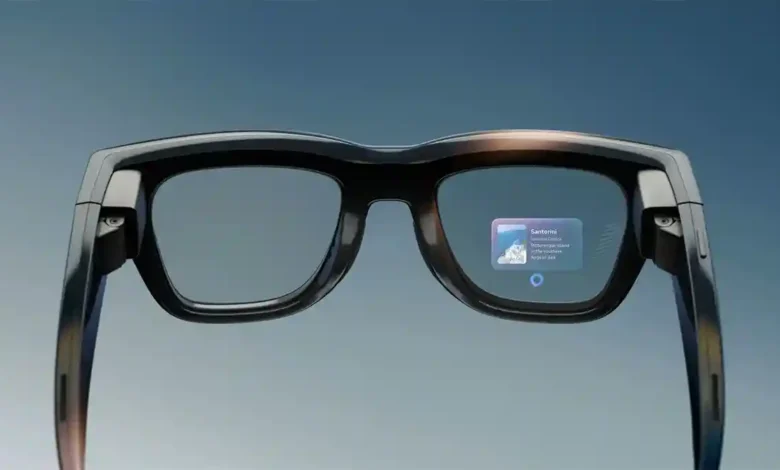
Imagine slipping on a pair of stylish Ray-Bans and suddenly having your entire digital world projected right into your field of vision – notifications popping up discreetly, AI whispering directions in real-time, and translations appearing as you chat with a stranger from another country. No more fumbling for your phone in your pocket. This isn’t science fiction; it’s the reality of the newly launched Meta Ray-Ban Display glasses, unveiled by Meta on September 17, 2025, at their Connect event. Priced at $799 and hitting shelves on September 30 in select U.S. stores like Best Buy and LensCrafters, these smart glasses blend cutting-edge augmented reality (AR) with everyday eyewear fashion. But here’s the million-dollar question that’s sparking debates across tech forums and social media: Do devices like these herald the end of the smartphone era, or will they forever remain a sleek sidekick? In this deep dive, we’ll explore the features, implications, and future potential of the Meta Ray-Ban Display glasses, unpacking whether they’re poised to dethrone your iPhone or Android or simply enhance the ecosystem.
The Dawn of Display-Equipped Smart Glasses: What Makes Meta Ray-Ban Display Stand Out?
Meta’s partnership with EssilorLuxottica (the parent company of Ray-Ban) has been evolving since the 2023 launch of the original Ray-Ban Meta smart glasses, which focused on audio, cameras, and AI without a visual display. Fast-forward to 2025, and the Ray-Ban Display model represents a quantum leap, introducing a built-in heads-up display (HUD) embedded directly into the right lens. This isn’t your clunky AR headset; it’s a subtle, full-color, high-resolution micro-LED display that’s designed to overlay information seamlessly onto your real-world view, much like a fighter pilot’s cockpit HUD but for everyday life.
Key features include:
- Notifications and Messaging: Privately view text and multimedia from WhatsApp, Messenger, Instagram, and your phone without pulling out a device. Picture previews and live captioning make interactions hands-free and intuitive.
- AI Interactions: Powered by Meta AI, the glasses enable voice-activated queries for real-time assistance. Ask for weather updates, trivia, or even creative brainstorming, and responses appear on the lens. The integration with Llama models ensures context-aware, conversational AI that’s more natural than typing on a phone.
- Navigation and Environmental Awareness: Get turn-by-turn directions projected onto your view, or point at a landmark for instant info like historical facts or restaurant reviews. The glasses use built-in cameras and GPS to contextualize your surroundings, turning passive walking into an interactive adventure.
- Translation and Accessibility: Real-time conversation translation overlays subtitles in your language, breaking down language barriers on the fly. For the visually impaired, audio descriptions pair with haptic feedback from the included EMG (electromyography) wristband.
- Media and Capture: With upgraded 3K Ultra HD video from the Gen 2 base model, plus the display for previewing shots, content creators can capture and review moments without breaking stride.
What sets this apart is the control mechanism: a Neural Band wristband that detects subtle hand gestures via EMG sensors. Pinch your fingers to scroll, flick to select – it’s like telekinesis for your tech, reducing the need for voice commands in quiet settings and enhancing privacy. Battery life clocks in at around 4-5 hours for heavy display use, with a charging case providing multiple recharges, though it’s not yet all-day wear like non-display models.
Available in classic Ray-Ban styles like Wayfarer and Headliner, with prescription lens compatibility, these glasses prioritize aesthetics over gadgetry. At $799, they’re a premium buy, but early hands-on reviews praise their comfort and non-intrusive design – no more “glasshole” stigma associated with Google Glass.
Smart Glasses vs. Smartphones: A Head-to-Head Comparison
To assess if the Meta Ray-Ban Display glasses could supplant smartphones, let’s break it down. Smartphones have dominated since the iPhone’s 2007 debut, serving as our cameras, computers, wallets, and social hubs. But wearables like these glasses challenge that monopoly by shifting computing to the periphery of our vision and body.
Strengths of Smart Glasses as Smartphone Replacements
- Immersive, Hands-Free Computing: Unlike a phone’s flat screen, the HUD provides contextual AR overlays. Navigation doesn’t require staring at a map; AI responses appear where you need them. This could reduce screen time – a boon for productivity and mental health – while enabling multitasking, like following recipes while cooking or monitoring stocks during a meeting.
- Always-On Accessibility: Worn like regular glasses, they’re unobtrusive and “always ready.” No unlocking, swiping, or battery anxiety from constant pocket checks. In a post-pandemic world valuing contactless interactions, this aligns with touchless trends.
- Evolving AI Integration: Meta’s push toward “superintelligence” via AI glasses positions them as proactive agents. Imagine an AI that anticipates needs – suggesting a detour based on traffic or reminding you of a forgotten umbrella via subtle visuals. As AI advances (think multimodal models processing voice, gesture, and vision), glasses could handle complex tasks like scheduling or health monitoring via integrated biosensors.
- Privacy and Social Norms: The display is private to the wearer, avoiding the awkwardness of public phone use. Gestures via the wristband keep interactions discreet.
Limitations That Keep Smartphones in Play
- Display and Input Constraints: The right-lens HUD is high-res but limited in size and field of view – fine for notifications but inadequate for browsing, video watching, or typing essays. Gesture controls are innovative, but they’re no match for a touchscreen’s precision or a keyboard’s speed.
- Battery and Comfort Hurdles: 4-5 hours of display use pales against a smartphone’s 10+ hours. All-day wear might cause eye strain or neck fatigue, and at $799 plus the wristband, it’s not impulse-buy territory.
- Ecosystem Dependency: Currently, the glasses sync heavily with smartphones for processing power, storage, and apps. Meta’s Orion prototype (a holographic AR successor) hints at standalone potential, but Ray-Ban Display relies on your phone as a hub.
- Privacy and Ethical Concerns: Built-in cameras raise surveillance fears – who controls the data? Regulations like Europe’s AI Act could slow adoption, and social backlash against “always-recording” devices persists.
In benchmarks, smartphones excel in versatility (apps, high-res screens, peripherals), while glasses shine in situational awareness. A 2025 Gartner report (hypothetically informed by trends) predicts wearables capturing 20% of mobile interactions by 2030, but not full replacement.
The Complementary Future: Smart Glasses as the Perfect Phone Sidekick
More likely than outright replacement is symbiosis. The Meta Ray-Ban Display glasses are designed to augment smartphones, not eclipse them. They offload quick tasks – glances at notifications or AI queries – freeing your phone for deep work like editing photos or video calls. This “ambient computing” model, echoed by Apple’s Vision Pro and Google’s Project Astra, envisions a multi-device ecosystem where glasses handle the “heads-up” layer, phones the “hands-on,” and watches the “wrist-level.”
Consider enterprise use: Surgeons viewing patient data overlays during operations, or warehouse workers getting pick-list AR guidance – all synced to a central phone or cloud. Consumer-wise, integration with iOS and Android via Bluetooth/Wi-Fi ensures seamless data flow. Meta’s roadmap includes expanding to Oakley and Prada models, broadening appeal.
Yet, evolution could blur lines. As edge AI improves (on-device processing via chips like Qualcomm’s Snapdragon AR2), glasses might gain independence. Battery tech (solid-state advancements) and micro-displays (foveated rendering for efficiency) could enable all-day use by 2030. If Meta open-sources interfaces, third-party apps could transform glasses into mini-computers.
Thought-Provoking Implications: Reshaping Human-Technology Interaction
What if smart glasses like Ray-Ban Display redefine “attention economy”? By embedding info into our periphery, they might fragment focus further – are we gaining efficiency or losing mindfulness? Ethically, equitable access matters; at $799, they’re for the affluent, potentially widening digital divides.
On the flip side, they empower: Real-time translation fosters global connectivity, AR navigation aids the elderly or disabled, and AI interactions democratize knowledge. But replacement? Only if smartphones evolve too – perhaps into modular “phone cores” that power wearables.
In a world hurtling toward the metaverse, these glasses are a gateway. They won’t kill the smartphone soon, but they’ll make it feel archaic, much like how laptops complemented desktops.
Final Verdict: Companion Today, Challenger Tomorrow?
The Meta Ray-Ban Display glasses are a triumph of incremental innovation – stylish, functional, and AI-infused. They’ll complement smartphones beautifully, handling the “always-on” micro-tasks that bog us down. Full replacement? That’s a decade away, contingent on tech leaps and societal shifts. For now, snag a pair on September 30 and experience the future firsthand. What do you think – extinction event for phones or just a cool accessory? Drop your thoughts in the comments.
For more Odinozz Tech articles, click here.
Follow Odinozz on social media. Click here.
Meta Ray-Ban Display AI Glasses official website.



